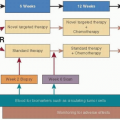Ophthalmic Metastases
Christopher A. Barker
Beryl McCormick
David H. Abramson
Ophthalmic metastases refer to secondary malignant neoplasms occurring in or around the eye. The uvea is the highly vascular middle layer of the eye and the most frequent site of metastasis. The choroid comprises the majority of the uvea and is the predominant location for uveal metastasis. Less frequently, metastases can arise in other parts of the uvea (ciliary body and iris), as well as extraocular structures (bones and soft tissues of the orbit, eyelids, extraocular muscles, and optic nerve). Importantly, metastases in any of these locations can dramatically affect vision. The contribution of vision to quality of life is significant; therefore, ophthalmic metastases can be a disabling sequela of breast cancer. This chapter presents concepts related to the epidemiology, biology, diagnosis, management, and outcome of ophthalmic metastases in patients with breast cancer.
EPIDEMIOLOGY
The true prevalence of ophthalmic metastases from breast cancer has been difficult to precisely determine, but necropsy and clinical series have provided estimates. Studies performed in the 1970s suggested that 10% to 37% of patients dying with, or of, metastatic breast cancer harbored orbital and/or ocular metastases on post mortem histologic examination (1, 2). However, a similarly designed study from a more recent era suggest 0% to 8% of patients harbor ocular metastases (3). Many have suggested that improvements in systemic therapy have led to a decreased prevalence of ophthalmic metastasis. These studies have clearly demonstrated that breast cancer metastasizes to the eye more frequently than other carcinomas.
Because of the prevalence of ophthalmic metastases noted in necropsy studies, several prospective screening studies have been carried out in visually asymptomatic patients with contemporary ophthalmic assessment methods (visual acuity assessment, slit-lamp examination, indirect ophthalmoscopy, with or without ultrasonography, see Table 80-1). Two of the studies were unable to identify any patients with ocular metastases, and concluded that screening was not worthwhile (4, 5). Another study found choroid metastases in 5% of screened patients (6). Of note, the latter study involved a younger group of patients with greater burden of disease and took place in an earlier time period than the former studies. The prevalence of ophthalmic metastases among patients with vision problems is likely higher than asymptomatic patients. One study reported that of 152 metastatic breast cancer patients with ophthalmic symptoms or signs, 58 (38%) were found to harbor choroid metastasis (7). Risk factors for the development of ophthalmic metastases are ill-defined. Some studies suggest that early age at initial diagnosis of breast cancer may be associated with higher risk (8). Others have noted a higher risk of ophthalmic metastasis in patients with greater disease burden (having metastasis in more than one organ, or the presence of brain or lung metastasis, but not liver or bone metastasis), but not initial tumor stage or presence of estrogen receptor on the primary tumor (6). Gender does not appear protective as men with breast cancer have been reported to develop ophthalmic metastasis.
BIOLOGY
The reason that breast carcinoma has a predilection to metastasize to the eye is unknown. Researchers investigated a small group of patients with ocular metastases from breast cancer, and found no clear aggregation of breast cancer in the family of affected patients, or any associations with common BRCA1 or BRCA2 gene mutations. However, the investigators noted that most women with ocular metastases were younger than 51 years at the time of initial diagnosis, suggesting an as of yet unidentified genetic relationship (8). The association of specific genetic aberrations and organ metastases from breast cancer has been described previously, and may explain the predilection (9).
Using animal models, investigators have reported that more than 50% of mice receiving an intracardiac injection of the r3T breast cancer cell line develop choroidal metastases. Pigmented abnormalities in the brain of mice with choroid metastases were frequently noted, suggesting a common mechanism in the development of brain and choroid
metastases. Moreover, in mice with choroid metastases, metastasis in the bone and lung metastases were observed in 71% and 92% of the animals. However, only 29% of the mice with choroid metastasis harbored liver metastasis. Animals with bone metastasis were not significantly more likely to harbor choroid metastasis. It was hypothesized that CXCR4 expression on r3T cells might explain the predilection for choroidal metastases, but this was not supported by experimental data (10).
metastases. Moreover, in mice with choroid metastases, metastasis in the bone and lung metastases were observed in 71% and 92% of the animals. However, only 29% of the mice with choroid metastasis harbored liver metastasis. Animals with bone metastasis were not significantly more likely to harbor choroid metastasis. It was hypothesized that CXCR4 expression on r3T cells might explain the predilection for choroidal metastases, but this was not supported by experimental data (10).
TABLE 80.1 Contemporary Prospective Ophthalmic Metastasis Screening Studies of Metastatic Breast Cancer Patients without Visual Symptoms | ||||||||||||||||||||||||||||||||||||||||||||||||||||||||||||
|---|---|---|---|---|---|---|---|---|---|---|---|---|---|---|---|---|---|---|---|---|---|---|---|---|---|---|---|---|---|---|---|---|---|---|---|---|---|---|---|---|---|---|---|---|---|---|---|---|---|---|---|---|---|---|---|---|---|---|---|---|
| ||||||||||||||||||||||||||||||||||||||||||||||||||||||||||||
Stay updated, free articles. Join our Telegram channel

Full access? Get Clinical Tree








